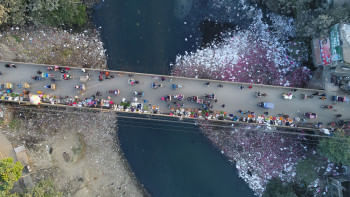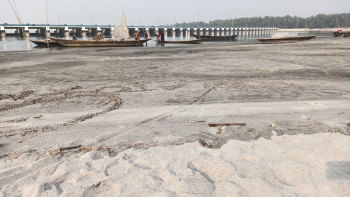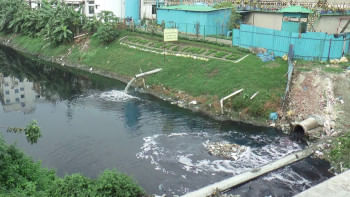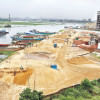Let Dhaka's rivers flow again

We commonly name Bangladesh as nodimatrik, implying that the river is mother to this deltaic land. Civilisation has always flourished here centring rivers. But over the decades, our rivers have lost their lustrous glory. And one strong manifestation of that is the river system of Dhaka.
Considering the present appalling state of the rivers in and around Dhaka, it feels quixotic to think that these water bodies could be restored to their natural forms. However, if things are dealt with strategically, from a policy perspective, there is still hope to one day have Dhaka's rivers flowing freely.
The first advantage is Dhaka's positioning and the frequency of rainfall here, as the city receives about 2,200 mm of rain annually. Therefore, if we can address pollution at its sources, our river system can function properly again, thanks to its quick-healing ecosystem and the rivers' lotic nature. If authorities can clean out even half of the pollution from Dhaka's rivers, nature will take care of the rest.
With a vision to turn this into reality, the Umbrella Investment Plan for Dhaka Rivers was prepared and adopted by the government. It aims to revitalise the Buriganga, Turag, Shitalakkhya, Balu and Dhaleshwari rivers, and make them flow better over the next seven years. In the plan, it was proposed that several ministries work together. Their responsibilities have also been outlined. The World Bank has done a survey and a set of projects have been selected through which to implement the master plan.
The aim of the plan should be realised through proper management of municipal solid waste and sewage, cleaning of polluted debris from the river beds, and the augmentation of river flow. As per the sewage master plan, Dhaka Wasa needs to establish fully functional sewage treatment systems in different regions to manage the sewage of the whole city. As industrial waste is a strong contributor to river pollution, factory owners must make their effluent treatment plants (ETP) operational before releasing effluent into the open environment. The capital's solid waste management needs to be handled by its two city corporations, as well as the ones in Gazipur and Narayanganj cities. Industrial waste management must be ensured by industry owners, in compliance with environmental regulations. The Bangladesh Inland Water Transport Authority (BIWTA) is in charge of cleaning rivers and disposing of dredged spoils in an environment-friendly manner. The Bangladesh Water Development Board (BWDB), meanwhile, will work for the augmentation of the rivers' flow.
The time has come to overcome institutional hurdles and steer the master plan towards an optimistic direction. Institutional capacity and political decisions play a crucial role here. But to implement the river master plan, we need better integration. The agencies concerned have not come under one umbrella yet. They need to sit together, mainstreaming the consideration of river restoration, and decide the coordination between the various projects. The members of the inter-ministerial committee should act proactively and steer the plan towards completion.
No doubt, it is complicated to implement projects that require the involvement of multiple bodies. Yet, there are instances of successful projects that multiple authorities have collaborated on. For example, in the government's Char Development and Settlement Project (CDSP), the duties of several agencies were made specific, funds were allocated for each agency, and provisions were made to spend the funds independently. Taking lessons from projects like this, those in charge of the river restoration plan could create an umbrella project with specific sub-components as delineated in the master plan. Development agencies and banks may be partners as per their suitability. To note, although the duration of the project is seven years, its benefits should start to show within two to three years. Hence, the authorities involved must not lose precious time by delaying their work any longer. If they miss even one monsoon, huge losses will be incurred in terms of the progress of the master plan.
Similarly, an active stance from the associated ministries and agencies is instrumental. A mix of top-down and bottom-up approaches is imperative. Each agency within the master plan needs to set specific targets for itself. The Department of Environment must be engaged during the whole duration of the river restoration plan and provide technical knowledge and support in areas of pollution management, environmental protection, and ecological restoration.
We suggest that the Dhaka river restoration master plan get the status of a megaproject. This will accelerate its progress optimally. It should be noted that the nature of this master plan is different from that of other infrastructure projects in terms of its lack of tangible progress. That is, the benefits of sewage treatment and industrial waste management are not as visible as the progress of infrastructural projects such as the Padma Bridge, Dhaka metro rail, or Terminal 3 of Dhaka airport. However, after the completion of the master plan, the benefits of ecological restoration of rivers around Dhaka will be clearly felt by the people living here.
The Dhaka river restoration master plan is ambitious, but it is not unrealistic. Given our aim of becoming a developed country by 2041, we cannot afford to have the rivers around our capital in such dire conditions. Clean rivers and cities are essential indicators of development. If the river master plan is implemented, the environment, water resources, and the ecology of Dhaka will improve significantly. The agencies concerned must move to action now, instead of remaining trapped within the rhetoric of policies and planning.
Dr Sultan Ahmed is associate director at Bangladesh Institute of Governance and Management (BIGM), former director-general of the Department of Environment, former chairman of Rajdhani Unnayan Kartripakkha (Rajuk), and former secretary of the Power Division.
Tasfia Tasneem Ahmed is research associate at BIGM.
Views expressed in this article are the author's own.
Follow The Daily Star Opinion on Facebook for the latest opinions, commentaries and analyses by experts and professionals. To contribute your article or letter to The Daily Star Opinion, see our guidelines for submission.


 For all latest news, follow The Daily Star's Google News channel.
For all latest news, follow The Daily Star's Google News channel. 









Comments